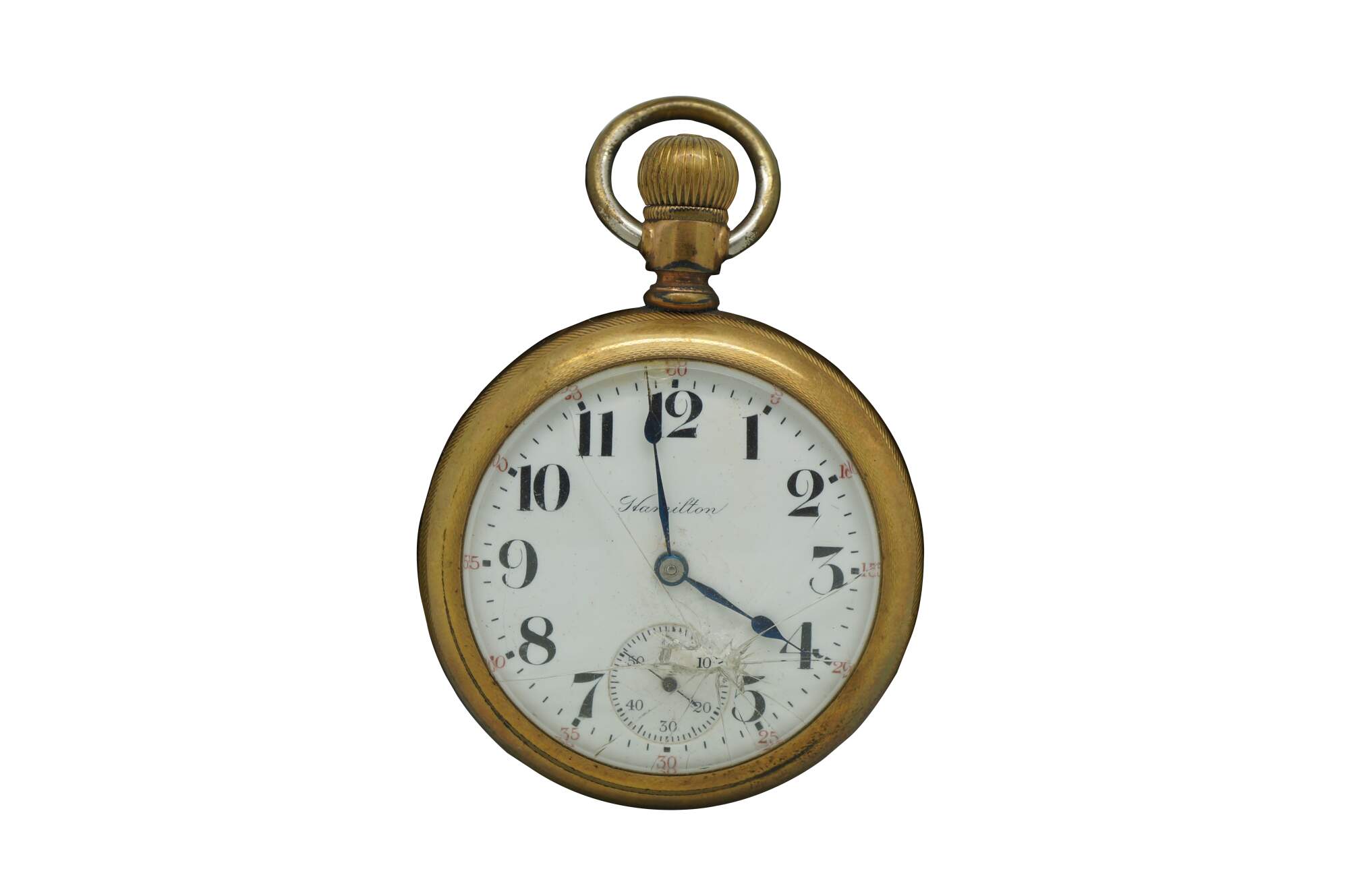
Shipping:
Free Shipping Included
Delivery:
Estimated 2-15 Business Days
Payments:
Credit Card, Check, Cash, PayPal, Apple Pay, Venmo
Returns:
30 Days 100% Money Back Guarantee, Buyer Pays Return Shipping
Description
Antique 1915 Hamilton openface pocketwatch. White face with black arabic numerals, auxilliary dial, and iridescent blue hands. Movement - Hamilton Watch Company, Lancaster, PA - Model 1 - Grade 924 - 17 Jewels - 18s - 1401298. Case - Philadelphia Watch Case Company - Guaranteed Twenty Years - 9936595.
"Hamilton Watch Company - Years of Operation: 1892-1969 - September 26, 1874 - E.F. Bowman creates a model watch at the Adams & Perry Watch Manufacturing Co. April 7, 1876 - The first movement was produced at the Adams & Perry Watch Manufacturing Company. August 1877 - Reorganized as the Lancaster Penn. Watch Co. in Lancaster, Pensylvania. September 1879 - The Lancaster Watch Co. had manufactured 334 movements. May 1883 - Reorganized as the Lancaster Watch Co. April 1886 - Reorganized as the Keystone Standard Watch Co. October 1892 - The Columbian Watch Co. is organized in Lancaster, Pennsylvania with a capital of $350,000. The Columbian Watch Co. absorbs the defunct Aurora Watch Co. and moves the factory machinery to Lancaster, Pennsylvania. December 14, 1892 - Reorganizaed as the Hamilton Watch Co. January 31, 1893 - The first Hamilton Watch Co. movement is sold to W.C. Davis, a 17-Jewel Openface 936 Grade Movement, Serial #15. First watch is produced by Hamilton Watch Co. 1928 - The 940 Railroade grade watch is discontinued. Purchased the Illinois Watch Co. September 16, 1930 - "Elinvar" is trademarked by the Hamilton Watch Company, establishing the rights to the name used for a special alloy patented by Charles Edouard Guillaume. 1931 - Hamilton Watch Co. obtains the rights to the "Howard" name. October 15, 1940 - The 992B Grade is introduced. 1969 - Last Hamilton watches are manufactured in the United States." (Source: Pocket Watch Database)
"Philadelphia Watch Case Co. Years of Operation: c.1889 - 1953. Predecessor: H. Muhrs Son. Successor: Keystone Watch Case Co. In 1884, Theophilus Zurbrugg formed a partnership with Daniel Leichty and Jacob Ott to manufacture cases in Philadelphia, Pennsylvania. Theophilus Zurbrugg & Co. manufactured cases at 140 South Third Street. Within a few years, Zurbrugg acquired the interests of the other members and organized the Philadelphia Watch Case Company around 1889. As the business expanded, Zurbrugg began looking for a location for a new factory. In 1892, the company was relocated to Riverside, New Jersey. In March 1898, Zurbrugg was able to absorb the case operation owned by H. Muhr's Sons, representing one of many consolidations implemented by Zurbrugg to commandeer market share. As explained in a public letter announcing the sale, Zurbrugg's original intent was to continue manufacturing gold-filled and silver cases at the Muhr plant while producing "base metal" cases (silver-filled, electro-plate, and nickel) at the Riverside factory. However, in July 1898, reports circulated that the Muhr case operation was being moved to a newly-completed expansion at the Riverside factory. Surprisingly, that expansion was not enough to house Zurgrugg's growth. By December 1898, the company was exploring the expansion of the factory again to accommodate new manufacturing. At this time, he formed the "T. Zurbrugg Company" to manage the case manufacturing subsidiaries of Philadelphia and Muhr. Following the death of George W. Child in 1894, the Keystone Watch Case Company was left without its largest shareholder. On July 1 1899, T. Zurbrugg & Co. merged with a reorganized Keystone Watch Case Company and was appointed Zurbrugg president. Based on reports, it is believed that George William Childs-Drexel was the man behind this deal, with Zurbrugg acting on the front lines. The Muhr brands were absorbed by the Philadelphia Watch Case Company, and the existing Keystone Watch Case Company continued its line of cases. Despite the perceived market division of these two companies, they were both part of Zurbrugg's expanding empire. Soon after, the Philadelphia Watch Case Company was incorporated again with a capital of $25,000. The incorporators were listed as Theophilus Zurbrugg, E.T. Stotsbury, J. Lowber Welsh, Caleb F. Fox, and Howard L. Roberts. The syndicate acquired other case companies to add to a growing portfolio, including Bates & Bacon, the Cresent Watch Case Company, and the American Watch Case Company of Toronto. In December 1899, the conglomerate made a move into the watch movements manufacturing industry, absorbing the New York Standard Watch Company for $752,000. Then, in May 1901, the company purchased the United States Watch Company in Waltham. Around this time, rumors began circulating that the company would also acquire the American Waltham Watch Company. Eventually, the Philadelphia Watch Case Company was reorganized as the Riverside Watch Case Works (of the Keystone Watch Case Company). In 1912, due to the massive consolidation of companies, an anti-trust suit was brought against the Keystone Watch Case Company." (Source: Pocket Watch Database)
Condition
Fair condition, wear and distressing, tarnish / oxidation / finish loss, cracked glass / hole - needs replaced, not tested but should work.
Dimensions
2.25" x 0.5" x 3.25" (Width x Depth x Height)